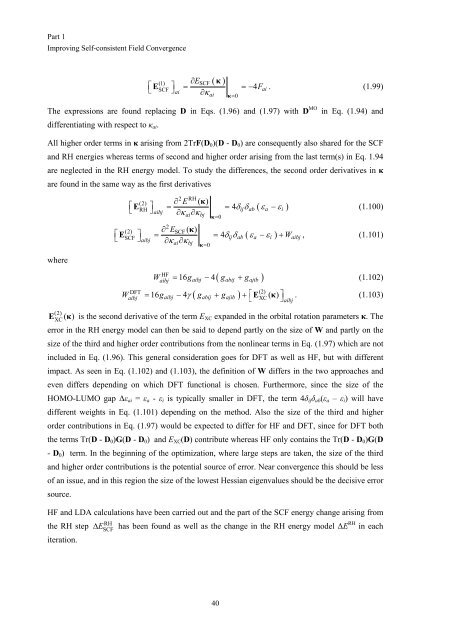Get my PhD Thesis
Get my PhD Thesis
Get my PhD Thesis
You also want an ePaper? Increase the reach of your titles
YUMPU automatically turns print PDFs into web optimized ePapers that Google loves.
Part 1<br />
Improving Self-consistent Field Convergence<br />
(1) ∂ESCF<br />
( κ )<br />
⎡ ⎤<br />
⎣<br />
E<br />
SCF ⎦<br />
= = −4F<br />
ai . (1.99)<br />
ai ∂κ ai κ=<br />
0<br />
The expressions are found replacing D in Eqs. (1.96) and (1.97) with D MO in Eq. (1.94) and<br />
differentiating with respect to κ ai .<br />
All higher order terms in κ arising from 2TrF(D 0 )(D - D 0 ) are consequently also shared for the SCF<br />
and RH energies whereas terms of second and higher order arising from the last term(s) in Eq. 1.94<br />
are neglected in the RH energy model. To study the differences, the second order derivatives in κ<br />
are found in the same way as the first derivatives<br />
2 RH<br />
(2) ∂ E ( κ)<br />
⎡ ⎤<br />
⎣<br />
E<br />
RH ⎦<br />
= = 4δ ij δ ab ( ε a −ε<br />
i )<br />
(1.100)<br />
aibj ∂κ<br />
∂κ<br />
2<br />
ai<br />
bj<br />
κ=<br />
0<br />
(2) ∂ ESCF<br />
( κ)<br />
⎡ ⎤<br />
⎣<br />
E<br />
SCF ⎦<br />
= = 4δδ ij ab ( ε a − ε i ) + W aibj , (1.101)<br />
aibj ∂κ<br />
∂κ<br />
ai<br />
bj<br />
κ=<br />
0<br />
where<br />
HF<br />
16 4( )<br />
W = g − g + g<br />
(1.102)<br />
aibj<br />
aibj abij ajib<br />
( )<br />
DFT<br />
Waibj<br />
= 16gaibj − 4 γ gabij + gajib<br />
+ ⎡ ( ) ⎤ ⎣<br />
E κ ⎦<br />
. (1.103)<br />
(2)<br />
XC<br />
aibj<br />
(2)<br />
E XC ( κ ) is the second derivative of the term E XC expanded in the orbital rotation parameters κ. The<br />
error in the RH energy model can then be said to depend partly on the size of W and partly on the<br />
size of the third and higher order contributions from the nonlinear terms in Eq. (1.97) which are not<br />
included in Eq. (1.96). This general consideration goes for DFT as well as HF, but with different<br />
impact. As seen in Eq. (1.102) and (1.103), the definition of W differs in the two approaches and<br />
even differs depending on which DFT functional is chosen. Furthermore, since the size of the<br />
HOMO-LUMO gap ∆ε ai = ε a - ε i is typically smaller in DFT, the term 4δ ij δ ab (ε a – ε i ) will have<br />
different weights in Eq. (1.101) depending on the method. Also the size of the third and higher<br />
order contributions in Eq. (1.97) would be expected to differ for HF and DFT, since for DFT both<br />
the terms Tr(D - D 0 )G(D - D 0 ) and E XC (D) contribute whereas HF only contains the Tr(D - D 0 )G(D<br />
- D 0 ) term. In the beginning of the optimization, where large steps are taken, the size of the third<br />
and higher order contributions is the potential source of error. Near convergence this should be less<br />
of an issue, and in this region the size of the lowest Hessian eigenvalues should be the decisive error<br />
source.<br />
HF and LDA calculations have been carried out and the part of the SCF energy change arising from<br />
RH<br />
the RH step ∆ E SCF<br />
has been found as well as the change in the RH energy model ∆E RH in each<br />
iteration.<br />
40

















